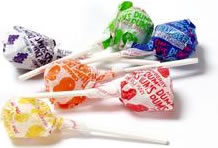The History of Lollipop Candy
by Jon Prince
The first incarnation of the lollipop was probably created by cave people thousands of years ago who collected honey from beehives with a stick. Not wanting to waste the sweet nectar, they most likely licked the stick, thus inventing the world’s first lollipop. Good for them (good for us). Archaeologists believe that ancient Chinese, Arabs, and Egyptians all produced fruit and nut confections that they "candied" in honey, which serves as a preservative, and inserted sticks into to make easier to eat.

If the 17th Century English version doesn’t count as the first modern lollipop, you could look to the Civil War era for another early forerunner, when hard candy was put on the tips of pencils for children. The early 20th Century was the era of automation, which is when the birth of the lollipop as we now know it begins in earnest, but there are still discrepancies as to who is the true creator.
In the 17th Century, as sugar became more plentiful, the English enjoyed boiled sugar candy treats and inserted sticks into them to make them easier to eat, too. Linguists say the term ‘lolly pop’ literally means ‘tongue slap’ (which we find hilarious) since the word for ‘tongue’ is ‘lolly’ in Northern England and ‘pop’ means ‘slap.’ London street vendors may have coined this term as they peddled the treat, which was soft rather than hard, but still considered a possible forerunner to the modern lollipop.
As early as 1905, the owner of the McAviney Candy Company may have stumbled upon the lollipop by accident. The company made boiled hard candies that were stirred with a stick, and at day's end, the owner brought the sticks covered with the candy home for his kids to enjoy. It wasn't until 1908 that he began to market these "used candy sticks."
Also in 1908, in Racine, Wisconsin, the first automated lollipop production was brought about by the Racine Confectionary Machine Company that introduced a machine that put hard candy on the end of a stick at the rate of 2,400 sticks per hour. Owners of the company believed that they could produce enough lollipops (although they weren’t called that yet) in a single week to supply the nation's demand for an entire year.
In approximately 1912, Russian immigrant Samuel Born invented a machine that inserted sticks into candy. The machine was called the Born Sucker Machine and the City of San Francisco considered it so innovative that they awarded him the keys to the city in 1916. George Smith, owner of a confectionary company called the Bradley Smith Company, took credit for inventing the modern version of the lollipop which he began making in 1908, and in 1931, he trademarked the term ‘lollipop,” borrowing the name from a famous race horse named Lolly Pop, which is when the term lollipop finally connects back to the 17th Century phrase (‘tongue slap,’ remember?).
As you can see, the development of the lollipop took its time and there is some competition for the title “creator of the lollipop,” but regardless who gets credit for it, it’s here to stay and it’s currently one of the most popular candies in existence. Modern companies such as the Spangler Candy Company (creator of Dum Dums, Saf-T-Pops, and other favorites) can produce up to 3,000,000 per day, which still hardly satisfies the nation's sweet tooth.
Lollipops today come in all shapes and sizes, and we offer more than 100 varieties. Whether you want a Charms Lollipop, a Tootsie Pop, or a lollipop with a cricket inside, our selection is second to none. So go ahead and order yourself and your loved ones a ‘tongue slap,’ and then enlighten them with all of your new knowledge; they’ll be so impressed. Finally, if we may end our History of the Lollipop with a lesson: when you don’t know what else to do, put a stick in it.

